When Should I Get Fitted For Golf Clubs
When should I get fitted for golf clubs is a smart question to ask if you want to play better golf. The best time to get fitted is before buying your first full set, after your swing changes, or if your current clubs don’t feel right anymore.
Many golfers also get refitted every 1–2 years as their body, strength, or skills improve.
Here’s a stat that might surprise you: 80% of golfers are playing with clubs that don’t fit them (PGA). That’s like trying to run a race in shoes that are too small.
A proper fitting checks your swing speed, shaft flex, lie angle, and grip size using tools like a launch monitor. This helps you find clubs that match your swing, so you can hit straighter, farther, and with more control on the course.
What Is Golf Club Fitting and Why Does It Matter for Every Golfer

Golf club fitting is when a professional checks how your swing works, your swing speed, launch angle, lie angle, and more, to build clubs that are just right for you.
It uses tools like a launch monitor to track your ball flight and clubhead speed, helping to custom-fit every part of the club, like the shaft flex, length, and grip size.
Even if you’re not consistent yet, getting fitted helps you avoid bad habits and gives you more confidence with every swing.
Golf Club Fitting Guide: When to Get Fitted and Why
| When to Get Fitted | Why It Matters |
| Before buying your first set | Avoid bad habits early and make sure your clubs match your size and swing |
| After swing changes or lessons | New swing = new needs; your old clubs may no longer fit properly |
| If shots are going short, high, or offline | Poor distance or control can mean the lie angle or shaft flex is wrong |
| Every 1–2 years | Your body, strength, or swing can change over time |
| After an injury or physical change | Injury or growth can affect grip size, stance, and swing path |
| When clubs feel uncomfortable | If clubs feel too heavy, long, or awkward, it’s a sign they don’t match your swing anymore |
| Moving from beginner to intermediate | As you improve, you need clubs that offer better feedback and control |
Note: This table helps you quickly spot the best times to get a club fitting based on how your body, swing, or game changes.
When Should a Beginner Golfer Get Fitted for Clubs
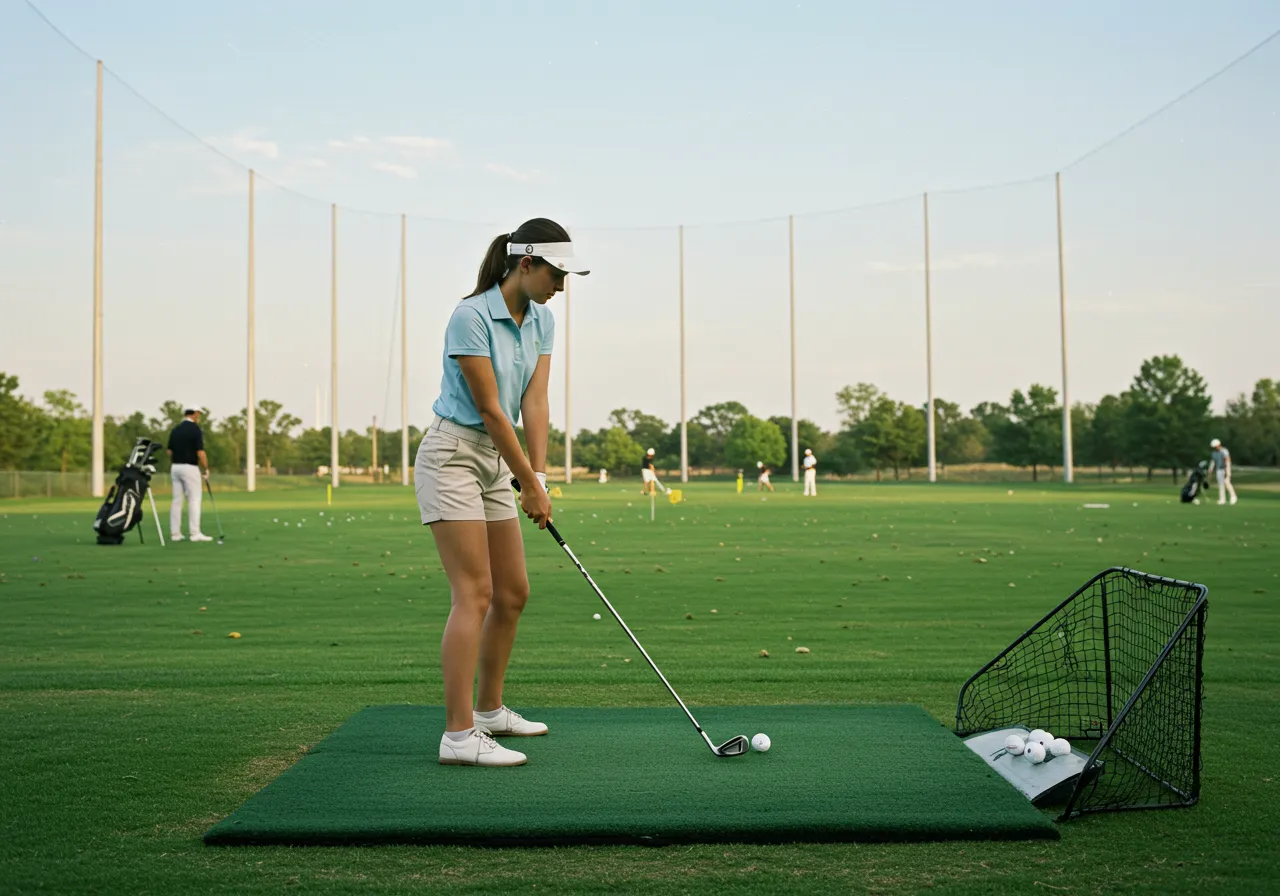
You don’t have to be a pro to get fitted. In fact, I recommend getting fitted before buying your first full set of golf clubs.
That way, you’ll build good habits with clubs that fit your height, strength, and swing speed.
If you’re already playing and struggling with distance, control, or comfort, it’s a strong sign you need a fitting, even if you’re just starting out.
Do Custom Fitted Golf Clubs Really Improve Accuracy and Distance
Yes, they absolutely do. I’ve seen players gain 10 to 15 extra yards just by switching to the right shaft and flex.
One of my students, a weekend golfer, dropped 5 strokes in two weeks after adjusting his lie angle and grip size. That’s the power of proper fitting, it fine-tunes your performance without changing your swing.
How Often Should You Get Fitted for Golf Clubs?
If you’re a growing junior, someone who’s had lessons, or just improved your swing, you should consider getting refitted every 1–2 years.
Also, if your swing speed changes or if you’re suddenly hitting shorter or less accurate shots, it might be time.
When Should You Get Fitted for Golf Clubs to Improve Your Game
Getting fitted for golf clubs is one of the smartest steps you can take to improve your performance, no matter your skill level.
Custom fitting isn’t just for pros. It’s about matching your equipment to your swing speed, ball flight, and body type. Below are five real signs that show you’re ready for a professional golf club fitting.
Why Consistent Ball Flight Means You’re Ready for Golf Club Fitting
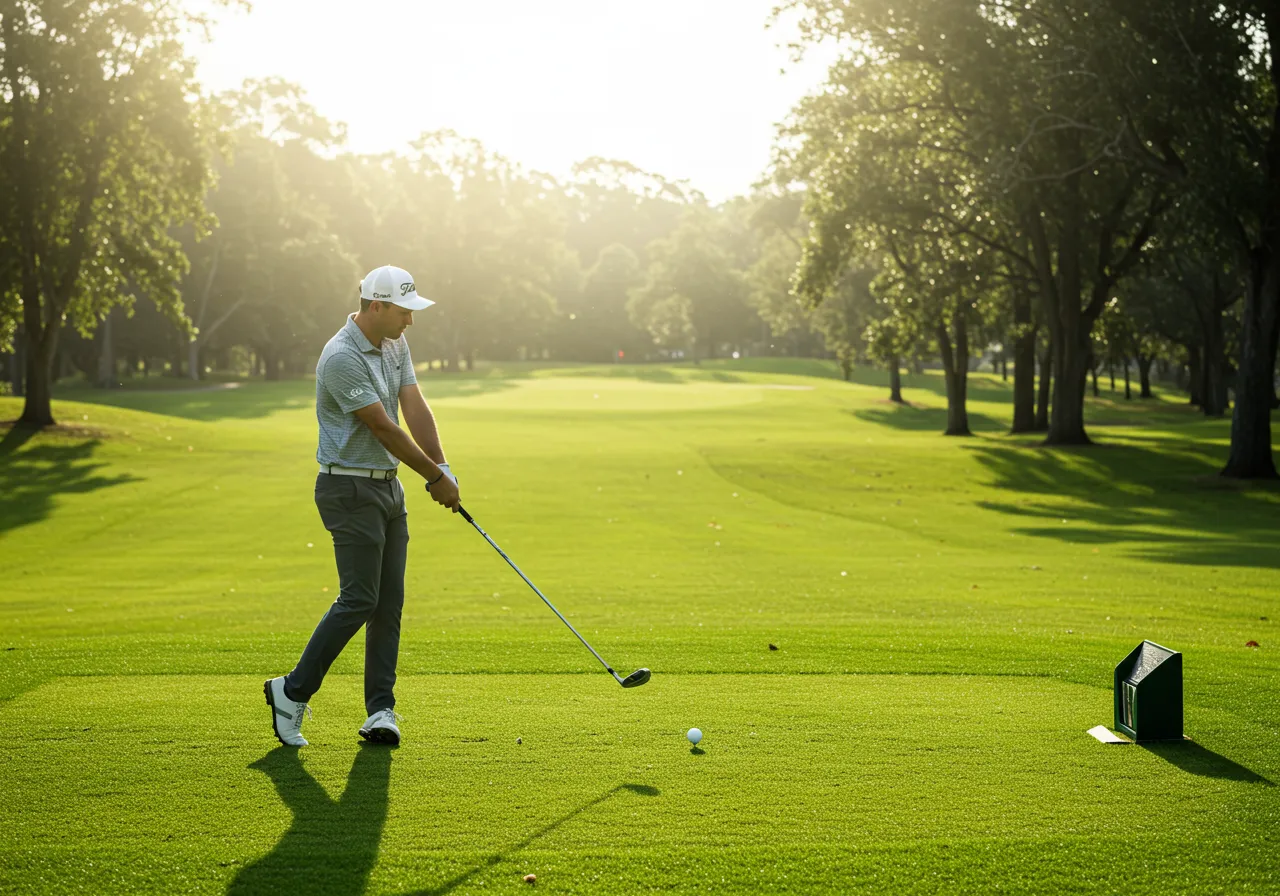
You don’t need a perfect swing, just a repeatable one
If you’re hitting about 7 out of 10 shots in the same direction or shape, your swing is ready for custom fitting.
That’s called a repeatable swing, and it gives fitters the data they need to analyze your swing path, launch angle, and clubface contact.
How swing speed and ball flight guide your fitting
Using a launch monitor, a fitter checks your swing speed, ball spin, and carry distance to recommend the right shaft flex, club length, and lie angle.
Even if your shots aren’t perfect, being consistent helps them build a setup that works with your swing, not against it.
Should You Get Fitted Before Buying a New Set of Golf Clubs
Don’t waste money on clubs that don’t fit
If you’re planning to buy new clubs, get fitted first. Major golf brands like TaylorMade, Callaway, and Ping often offer free or discounted fitting sessions with a purchase.
Off-the-shelf clubs may not match your grip size, clubhead weight, or shaft length, which can hurt your progress.
Custom fitting gives you long-term performance value
A one-hour fitting can save you years of bad habits and frustration.
Custom clubs help you improve faster by matching your current strength, height, and swing style, so your new set performs from day one.
Can Golf Club Fitting Help You Break a High Handicap Player

Your handicap is stuck, and your clubs may be the reason
If your golf handicap hasn’t improved in months, it might not be your swing; it could be your clubs. I’ve coached players who stayed around a 16 handicap for years.
After a proper club fitting, they dropped 3 to 5 strokes in just a few rounds.
Why club forgiveness and shaft flex matter
A fitting session adjusts key variables like shaft flex, face angle, and club forgiveness.
These tweaks help you hit straighter, reduce mishits, and get better distance even if your swing isn’t perfect. That’s the secret to breaking plateaus.
When Do Physical Changes Mean You Need a Golf Club Re-Fitting
Your body changes, and so should your clubs
Your swing depends on how your body moves. If you’ve had a recent injury, surgery, or changes in flexibility, your swing mechanics may shift.
This is also true if you’re a junior golfer still growing or a senior golfer losing mobility.
What to update when your posture or motion changes
Fitters will re-check your club length, lie angle, and grip size to make sure your clubs still match your natural posture and swing arc.
Even small changes in your body can affect ball contact and consistency.
Do You Need to Upgrade Your Clubs If They’re Over 5 Years Old
Outdated clubs may limit your distance and control
Golf technology moves fast. If you’re using clubs that are 5 to 10 years old, you’re likely missing out on major improvements in shaft materials, clubhead speed, and face technology.
Today’s clubs are designed to launch the ball higher and farther with less effort.
How new technology improves launch angle and swing results
Newer shafts, forged clubfaces, and weight balancing give you better energy transfer and ball flight control.
If your current gear doesn’t have adjustable hosels or high-speed face inserts, a fitting can show you how much you’re missing.
When Should You Book a Professional Golf Club Fitting
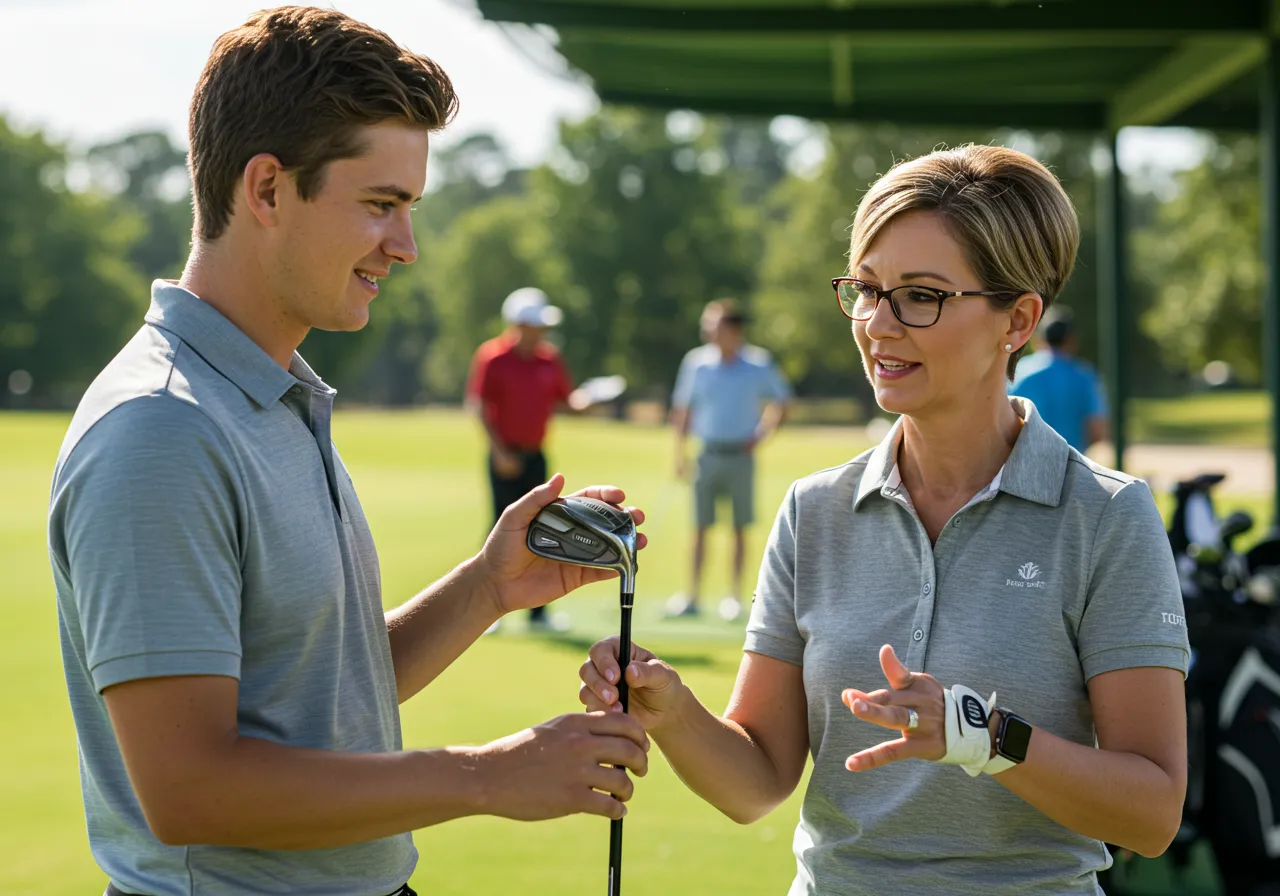
You should get fitted for golf clubs when:
- You have a consistent swing (not perfect, just repeatable)
- You’re planning to buy a new set of clubs
- Your handicap isn’t improving despite practice
- You’ve experienced physical changes or injuries
- Your clubs are more than 5 years old
Club fitting is not just about making gear changes; it’s about understanding your swing DNA and giving you the best tools to succeed.
With the right fit, even average swings feel more solid, and small improvements turn into lower scores.
Golf Club Fitting Readiness Table: Signs, Reasons, and What It Fixes
| Sign You’re Ready for Fitting | Why It Matters | What Fitting Helps Fix |
| You have a repeatable swing | A consistent swing pattern gives accurate fitting results | Shaft flex, lie angle, swing path alignment |
| You’re buying new clubs | Off-the-rack sets don’t match your height or swing | Club length, grip size, and launch optimization |
| Your handicap is stuck or not improving | Poorly fit clubs reduce forgiveness and limit progress | Forgiveness, accuracy, and distance control |
| Your body has changed (injury, age, growth) | Swing mechanics shift with physical changes | Lie angle, club length, grip thickness |
| Your clubs are 5+ years old | Technology has improved, old clubs may not match your swing speed or launch needs | Updated shafts, clubhead design, ball speed improvements |
Note: If you match even one of these signs, it’s likely time to book a club fitting. Many fitters use tools like TrackMan, GCQuad, or other launch monitors to give you data-driven recommendations that match your swing style and physical needs.
Who Should Get Fitted for Golf Clubs Based on Skill Level
Not all golfers need the same kind of fitting. From total beginners to low handicappers, the timing, tools, and focus areas are different.
As a golf coach, I’ve seen players at all levels benefit when the fitting matches their experience and swing consistency. Let’s break it down.
Golf Club Fitting for Beginners: When Is the Right Time to Start
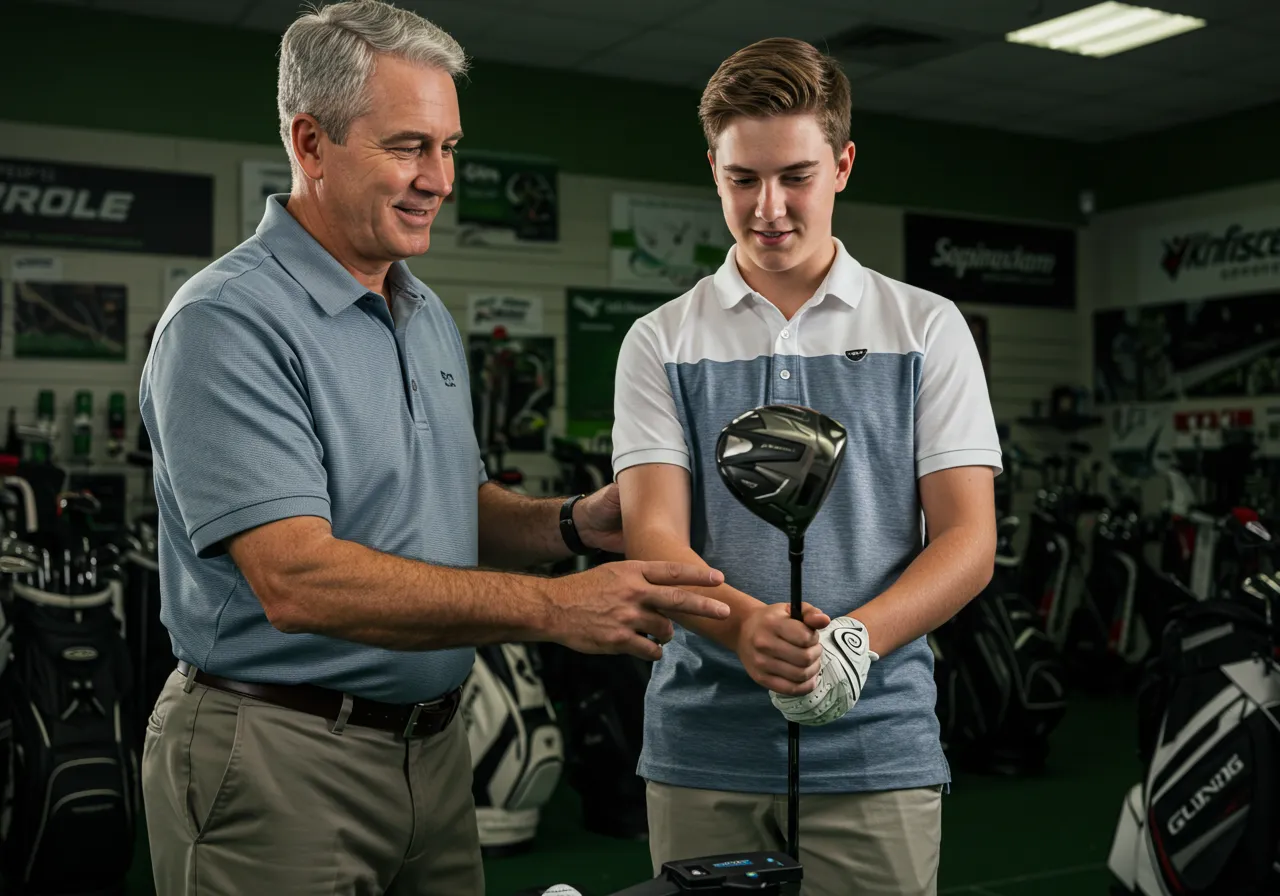
Ideal timing: After 5–10 lessons and consistent ball contact
If you’re new to golf with a handicap above 30, don’t rush into custom clubs right away. Focus on learning the basics and building a repeatable swing first.
Once you’re making solid contact most of the time, a fitting becomes useful.
What beginners should focus on during a fitting
In beginner fittings, we check:
- Shaft flex (too stiff or too soft can cause mishits)
- Lie angle (helps control direction)
- Grip size (too big or too small affects feel)
- Club length (important for posture and control)
Most new golfers benefit from game-improvement club heads that offer more forgiveness and help get the ball in the air.
Golf Club Fitting for High Handicappers: How to Reduce Slices and Hooks
Handicap range: 15–30
This is where I see the biggest changes after a fitting. Many high-handicap golfers struggle with ball direction, lots of slices or hooks. The #1 reason? Wrong lie angle.
Key stat: 25% tighter shot dispersion after proper lie angle adjustment
We use a lie board test and launch monitor to fix those direction issues.
A fitting also adjusts shaft flex, clubhead weight, and grip feel to match your natural swing speed and rhythm. This
Golf Club Fitting for Low Handicappers: How to Fine-Tune Your Gaps and Launch
Handicap range: Under 10
For more advanced players, fittings get more precise. It’s not about fixing direction, it’s about fine-tuning performance.
Tools we use: TrackMan or GCQuad launch monitors
We use high-tech tools to dial in:
- Launch angle
- Spin rate
- Carry and total distance gaps
- Club speed and ball speed
I had a student shooting in the 70s, but once we checked his gapping, we found his 6- and 7-irons were only 5 yards apart.
A simple shaft tweak gave him clean 10-yard spacing throughout his bag.
Match Your Golf Club Fitting to Your Current Skill Level
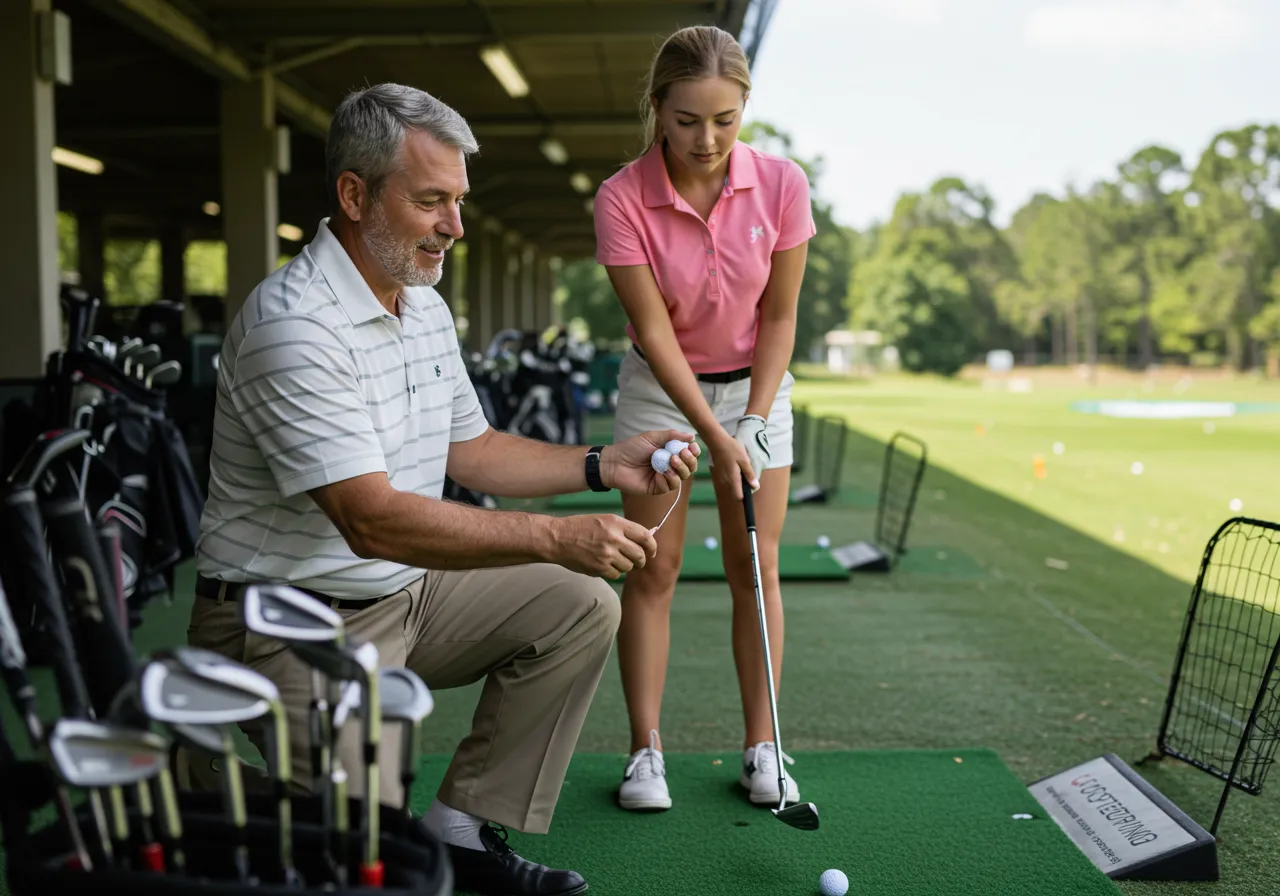
Don’t get the same fitting as a tour player if you’re still learning to swing. The best results come when fittings are matched to where you are right now, not where you hope to be.
That’s how you grow faster and play smarter.
What Should You Expect During a Professional Golf Club Fitting
A club fitting isn’t just about trying clubs, it’s about finding the ones that fit you.
As a coach, I’ve seen players gain distance, accuracy, and confidence after one solid fitting. Here’s exactly what to expect before, during, and after the session.
What Tools Are Used to Fit Golf Clubs to Your Swing
High-tech systems give you accurate swing feedback
When you go in for a fitting, the coach or fitter will use advanced tools to measure your swing. These include:
- High-speed swing analyzers
- Ball-tracking launch monitors like TrackMan or GCQuad
They measure things like how fast you swing, how high the ball launches, how much it spins, and how far it carries.
Based on those numbers, they choose the best shaft, grip, and clubhead setup for your swing.
How Long Does a Golf Club Fitting Take
Fitting sessions are short but detailed
Depending on what you’re getting fitted for, the session can be quick or a bit longer:
| Type of Fitting | Time Required |
| Irons Only | 60 minutes |
| Driver Only | 45 minutes |
| Full Bag (All Clubs) | 90 minutes |
You’ll hit several shots with different clubs while the fitter compares how they perform. It’s not just about how far you hit, it’s about consistency and control.
How Much Does a Golf Club Fitting Cost
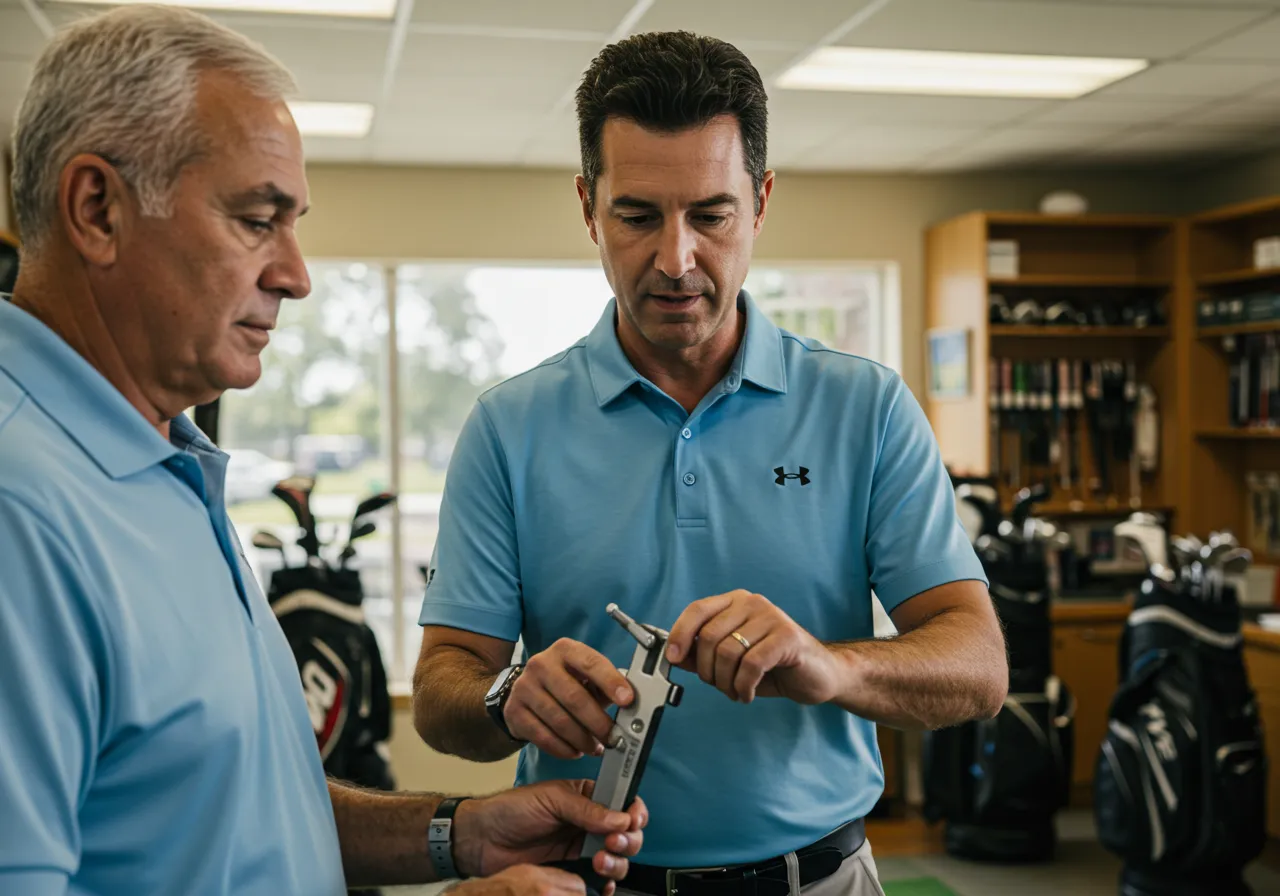
You may not have to pay at all
Fittings usually cost between $50 and $150, depending on the location and what’s being fitted.
But here’s the good part: many golf stores take off the fitting fee if you buy clubs after the session. So, if you’re already planning to upgrade, the fitting might be free.
What Should You Bring to Your Club Fitting Appointment
Come, like you’re ready for a real round of golf
Bring the gear and mindset you’d use on the course:
- Your current clubs (so the fitter can compare)
- Golf shoes or sneakers that you normally wear
- Comfortable clothes so you can move easily
- With a good attitude and a little patience, you’ll be swinging a lot
The more prepared you are, the more accurate the results will be. Some players swing better just because they feel more at home with their own gear.
Everything You Need to Know Before Getting Fitted
| Category | Details |
| Tools Used | TrackMan, GCQuad, swing analyzers |
| Time Needed | 45–90 minutes, depending on what’s being fitted |
| Typical Cost | $50–$150 (often waived with a club purchase) |
| Bring With You | Your current clubs, comfortable outfit, and mindset for real swings |
Debunking the Most Common Myths About Golf Club Fitting

Golf fitting is often misunderstood. I’ve heard every excuse from players over the years, beginners, seniors, even single-digit handicappers.
But the truth is, most of these beliefs are based on old thinking. Let’s clear up the confusion and get to the facts.
Do Only Pro Golfers Need to Get Fitted for Clubs
Truth: Beginners need fitting the most
One of the biggest myths I hear is “fitting is just for professionals.” Not true. In fact, beginners often see the biggest improvement after a fitting.
Why? Fitted clubs offer more forgiveness, help you build better habits, and make it easier to hit clean shots from day one.
I’ve seen total beginners gain 20+ yards just by switching to the right shaft and lie angle.
Should You Fix Your Swing Before Getting Fitted
Truth: Bad clubs often create bad swing habits
Many golfers wait until their swing is “perfect” before booking a fitting. But here’s the thing—bad clubs can cause bad swings.
If a shaft is too stiff or the grip is too big, you’ll start compensating in your swing without even realizing it.
Fitting helps you build the right swing from the start with clubs that fit your posture, speed, and timing.
Are Custom Fitted Golf Clubs Always Expensive
Truth: Many retailers offer free fittings with purchase
It sounds expensive, but in reality, most big golf stores offer free fittings when you buy clubs. Places like PGA Superstore and Golf Galaxy waive the fee when you purchase a set.
So instead of spending more, you’re just making your money go further with a smarter choice.
Is Driver Fitting the Only One That Matters
Truth: Wedges and putters give the best return
Yes, drivers are important, but wedges and putters are where you score. I always remind my students: you hit more putts than drivers in every round.
A good wedge fitting improves spin control. A putter fitting helps with alignment and distance feel.
If you care about dropping strokes, get those clubs fitted too.
Is There a Right Age to Get Fitted for Golf Clubs
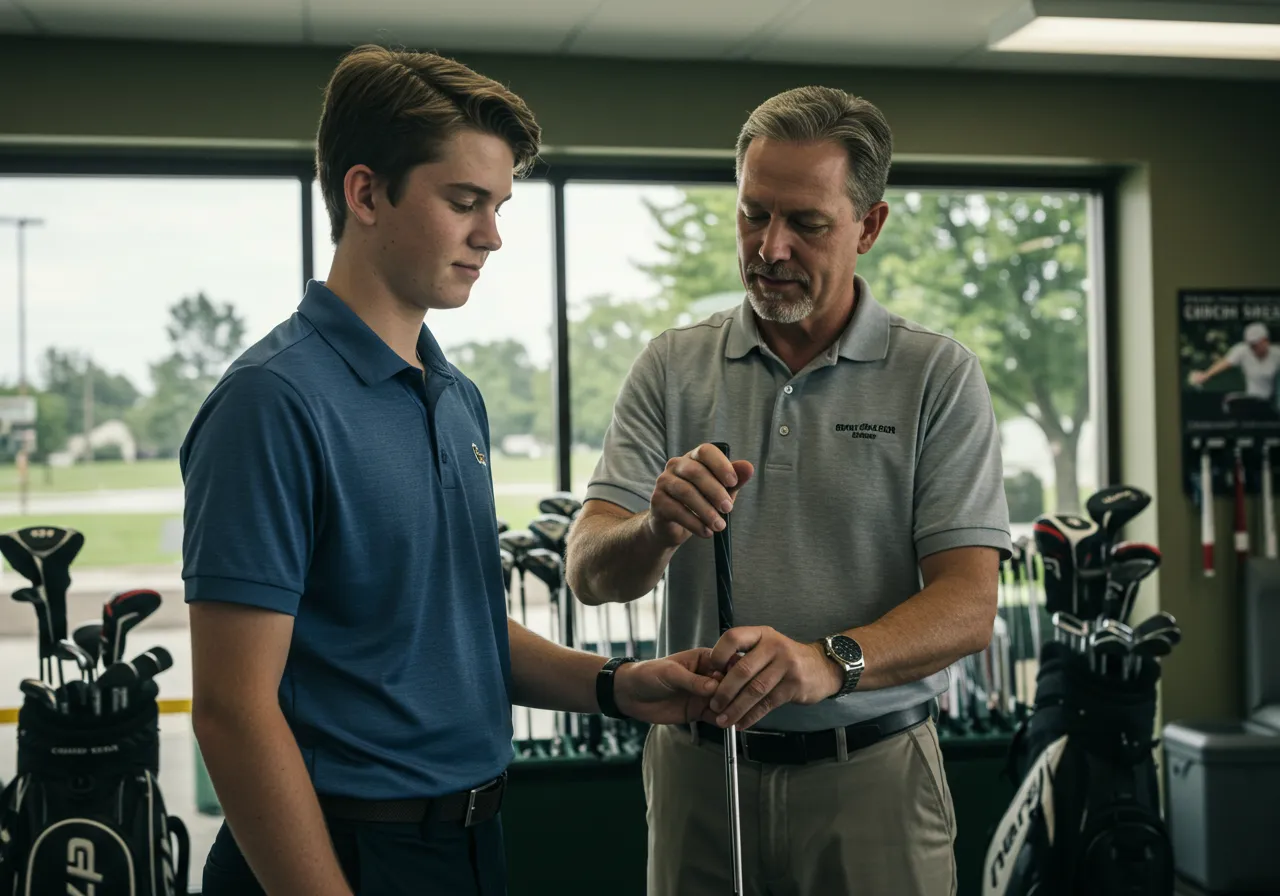
Truth: Golfers from age 12 to 80+ benefit from fittings
I’ve worked with junior golfers and senior players alike, and both see big benefits.
A 12-year-old might need junior flex shafts, while someone over 70 may need senior flex with lighter weights to keep the speed up.
If you can swing a club, you can benefit from a fitting. Age doesn’t matter, fit does.
Are Off-the-Rack Clubs the Same as Fitted Clubs If Specs Match
Truth: Factory-built clubs don’t match custom quality
Even if you match specs like shaft flex and loft, off-the-rack clubs can still feel off. Why? Because custom-built clubs are matched precisely to your swing.
They have tighter tolerances, meaning better balance, consistent weights, and smoother feel.
It’s like buying a suit in your size versus getting it tailored; both fit, but one fits better.
Do You Only Need One Golf Club Fitting in Your Life
Truth: Refit every 1–2 years as your swing changes
Your body, swing, and skill level change over time. I recommend checking your fit every 1–2 years, especially if your speed, posture, or strength changes.
Even small updates in shaft length or lie angle can improve your shot consistency.
Golf isn’t a one-time game, nor is it fitting.
Don’t Let Myths Stop You from Getting Fitted
If you’ve heard any of these myths and held off on a fitting, now you know the truth. Golf fitting is about making your swing easier and your scores lower, no matter your age, skill, or budget.
I’ve seen it change players’ games completely. One small step, big long-term difference.
Should You Get Fitted for Golf Clubs Before or After Taking Lessons
I get asked this all the time by my students: “Should I take lessons first, or get fitted for clubs?” The answer depends on where you are in your golf journey.
Let’s break it down simply based on your skill level and goals.
For Beginners: Should You Take Golf Lessons Before Getting Fitted
Start with lessons, then get a basic club fitting
If you’re just starting out and have a handicap above 30, your first move should be swing lessons.
Learn how to grip the club, make solid contact, and repeat your motion. After about 5 to 10 lessons, once you’re hitting the ball consistently, it’s time for a basic club fitting.
This helps make sure your clubs fit your size and swing shape, without going too deep into advanced fitting details. After you improve more, you can always get refitted for even better results.
Beginner path:
Lessons → Basic Fitting → Advanced Lessons → Full Re-Fit
For Experienced Golfers: Should You Get a Club Fitting Before More Lessons

Lock in the equipment first, then fine-tune the swing
If you’ve been playing for a while and already have a repeatable swing, I recommend getting fitted first. This gives you clubs that match your natural motion, which helps your lessons become even more effective.
Once you take more lessons and change your swing shape or speed, go back and get re-fitted to match the new version of your game. This cycle keeps your equipment in sync with your progress.
Experienced golfer path:
Fitting → Lessons → Re-Fitting (to match swing changes)
Why Taking Lessons Without Properly Fitted Clubs Can Hold You Back
Bad clubs can cause bad habits, even with good coaching
I’ve seen many students blame themselves when the real issue was their clubs. Too stiff? Too long? Too heavy?
All of these can make even a well-coached swing break down. If you’re learning with clubs that don’t fit, you’re training your body around problems that aren’t your fault.
That’s why fitting and lessons go hand in hand. The goal is to improve your swing and give it the right tools to grow.
Which Should Come First, Golf Lessons or Club Fitting
Golf is a journey, not a one-time fix. The more your swing changes, the more your clubs should adapt too.
Lessons shape your skills, fitting shapes your tools. Together, they’re the fastest path to lower scores.
Golf Lessons vs. Club Fitting: What Should Come First
| Category | Golf Lessons First | Club Fitting First |
| Best For | Beginners with no consistent swing | Experienced golfers with a repeatable swing |
| Main Focus | Build fundamentals: grip, stance, swing path | Match equipment to the current swing and body type |
| When to Do It | Before buying new clubs | If you’re playing regularly but lack distance or control |
| What It Improves | Mechanics, contact, consistency | Launch angle, accuracy, ball flight, distance |
| Typical Next Step | Basic fitting after 5–10 lessons | Take lessons to improve technique, then re-fit clubs |
| Mistake to Avoid | Practicing with poorly fit clubs | Fitting before having any swing to measure |
| Long-Term Plan | Lessons → Fitting → Advanced lessons → Re-fit | Fitting → Lessons → Re-fit to match swing changes |
Note: You don’t have to choose just one forever. Think of lessons as shaping your swing and fitting as sharpening your tools. Done in the right order, they work together to build confidence, consistency, and lower scores.
How Do You Know It’s Time to Get Re-Fitted for Golf Clubs

Even if your clubs were fitted in the past, that setup might not work forever. As your swing, body, or golf goals change, your clubs should change with you.
Based on my coaching experience, here are 5 clear signs that you might need a refitting, and what to do about them.
Has Your Golf Swing Speed or Tempo Changed When Using a Golf Club
Faster or slower swings can cause fitting issues
If your swing speed has gone up or down, maybe from more practice, better fitness, or just getting older, your current shaft flex might be wrong for you.
A swing that feels faster may need a stiffer shaft. A slower swing might need something lighter to get the ball in the air.
If you feel like the club is lagging behind or too hard to control, it’s time for a checkup.
Are You Struggling with the Same Ball Flight Mistakes
Slices, hooks, or balloon shots that won’t go away
If you keep seeing high slices, low hooks, or shots that feel out of control, even with good contact, your club’s lie angle, loft, or shaft profile might be off.
I’ve seen players blame their swing when it was really their equipment causing the trouble.
When the flight pattern doesn’t match your intent, it’s a sign to re-fit.
Have You Had Any Physical Changes Recently For Playing Golf
Injury, arthritis, or body changes affect your swing
If you’ve gained or lost weight, lost flexibility, or developed issues like arthritis, your swing mechanics will change, and so should your clubs.
I once re-fitted a senior golfer with arthritis by adding larger grips and a lighter shaft. He gained 12 yards without changing his swing.
Comfort and control are the goals here.
Are You Still Using Golf Clubs That Are Over 5 Years Old
Older clubs may not match today’s swing data
Golf club technology changes fast. If your clubs are more than five years old, they may be holding you back.
New materials, shaft designs, and face technology can improve ball speed, launch angle, and control, even with the same swing.
If you’ve never checked how your clubs compare to modern options, now is the time
Has Your Score Stopped Improving Even Though You Practice Golf

Plateaus can mean your gear isn’t keeping up
If you’re practicing regularly but your scores won’t drop, the issue might be your clubs.
I’ve seen mid-handicap players gain instant consistency by adjusting their lie angles, shaft weight, or gapping between irons.
Sometimes it’s not your effort, it’s your equipment needing an update.
Don’t Guess, Get Checked If These Signs Sound Familiar
If even one of these sounds like you, it’s worth booking a refitting session. It’s not about buying more clubs, it’s about making sure your current ones are working with your swing, not against it.
FAQs
Should I get fitted before or after golf lessons?
If you’re a beginner, take a few lessons first to build a consistent swing. Once you can hit the ball solidly 7 out of 10 times, get a basic fitting. For experienced players, a fitting before lessons helps fine-tune your swing with the right equipment.
How do I know if I need to get fitted for golf clubs?
You may need a fitting if:
- Your shots are going too high, too low, or off target
- You feel uncomfortable with your clubs
- Your swing speed has changed
- You’re buying a new set or struggling to improve
How often should you get fitted for golf clubs?
Get re-fitted every 1–2 years or sooner if your swing, strength, or flexibility changes. Also refit if you’re using clubs that are 5+ years old or you’ve had recent lessons or injury.
Can beginners benefit from golf club fitting?
Yes. Beginners often improve faster with fitted clubs. Basic fitting helps you start with the right shaft flex, club length, and grip size so you build good swing habits early.
Is a golf club fitting worth it?
Absolutely. A proper fitting can improve your accuracy, distance, and ball flight without changing your swing. It’s one of the smartest upgrades you can make at any level.
What do they check in a golf club fitting?
Fitters analyze:
- Swing speed
- Launch angle
- Lie angle
- Ball flight
- Grip size
Using launch monitors like TrackMan, they match clubs to your body and swing style.
What should I bring to a club fitting appointment?
Bring:
- Your current clubs
- Golf shoes or sneakers
- Comfortable clothes
- A focused mindset (you’ll hit 30–50 shots)
Is a free fitting as good as a paid fitting?
Yes, if done at a reputable shop with proper tools (like a launch monitor). Many retailers offer free fitting with club purchase, which gives you top-quality data without extra cost.
How long does a golf club fitting take?
It depends:
- Irons only: ~60 minutes
- Driver only: ~45 minutes
- Full bag fitting: ~90 minutes
Final Thought: Your Clubs Should Fit You, Not the Other Way Around
If you’ve been holding off because you think fittings are only for pros or too expensive, think again. A proper fitting is often free, saves you money long-term, and helps you enjoy golf more from the very first swing.
Better golf doesn’t come from buying more gear; it comes from owning the right gear. So take the first step: find a fitter, book a session, and let your clubs work for you.
Are NEW golf clubs a waste of money
Posts References:
When is the best time of year to get fit for new golf clubs
10 Reasons to Get Fitted For New Golf Clubs